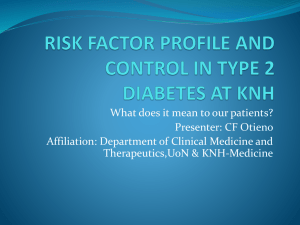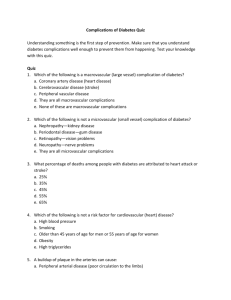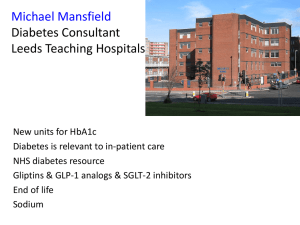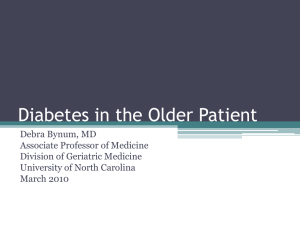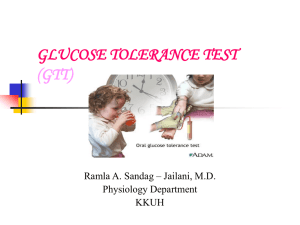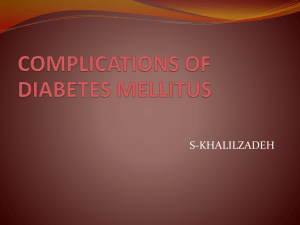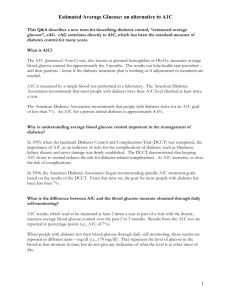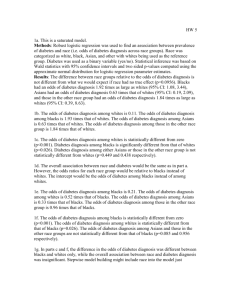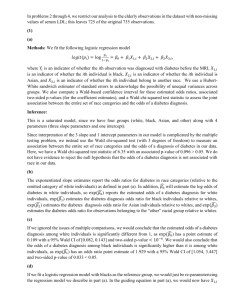Facts and Fiction about Type 2 Diabetes
advertisement
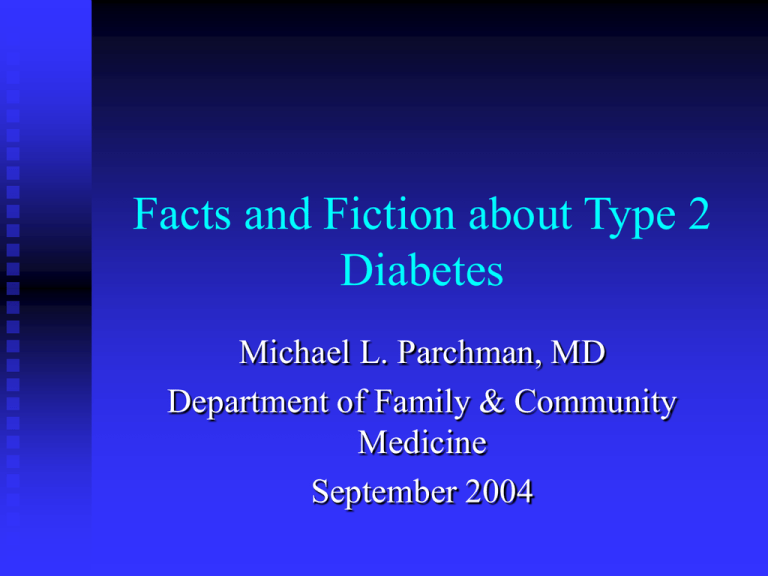
Facts and Fiction about Type 2 Diabetes Michael L. Parchman, MD Department of Family & Community Medicine September 2004 Complications from Type 2 Diabetes Microvascular Retinopathy Neuropathy Nephropathy Autonomic: gastroparesis, blood pressure Macrovascular MI CVA Claudication/PVD Preventing Complications from Type 2 Diabetes Glucose Blood Pressure Lipids What is the Evidence? UKPDS The only large study of patients with Type 2 DM of new onset 20 year study conducted in 23 centers in the U.K. More than 5,000 patients enrolled Primary Aim: determine the effect of intensive control of glucose on 21 predetermined endpoints. Added a secondary arm to study the effect of blood pressure and lipid control. Glucose: Fact or Fiction? Tight control of blood glucose improves mortality. FACT: Tight control of blood glucose did not prevent premature mortality Glucose: Fact or Fiction? All patients with type 2 diabetes benefit from treatment with metformin. FACT: In overweight patients, metformin decreased mortality related to diabetes or other cause (13.5 v. 20.6 events per 1000 pt yrs, NNT per year=141) AND diabetes related complications (29.8 v. 43.3 events/1000 pt yrs) “Overweight patients with type 2 DM seem to benefit not so much from the overall control of glucose but rather from taking metformin.” Glucose: Fact or Fiction? Tight control of blood glucose prevents the onset of microvascular and macrovascular complications. FACT: Changes in HbA1c produced by intensive drug treatment did not correlate with microvascular or macrovascular outcomes. FACT: In overweight patients, treatment with insulin or sulfonylureas had no effect on individual or aggregate microvascular or macrovascular outcomes. BP: Fact or Fiction Tight blood pressure control prevents macrovascular but not microvascular complications FACT: Tight control of blood pressure decreased likelihood of ALL 21 different endpoints, microvascular, macrovascular and mortality. Control of BP had greater effect on complications than glucose control (24% v. 12% decreased risk in diabetes related complications BP: Fact or Fiction Diastolic blood pressure is a more important risk factor for MI and stroke than systolic FACT: Systolic BP is a more important risk factor for MI and stroke than diasolic. FACT: Each 10mm Hg reduction in systolic BP associated with 12% reduction in risk for ANY complication of diabetes FACT: No lower threshold for any complication below which risk no longer decreased. Systolic BP and Incidence Rate of Any DM Complication How Do We Get This Low? UKPDS: Over 60% of patients in “tight” BP control group requires 3 or more drugs2 (“tight” = mean BP 144/82) Lipids: Fact or Fiction Patients with type 2 diabetes and no history of CVD should have an LDL level of <130 FACT: Heart Protection Study* T2DM over age 40 Total Cholesterol over 135 LDL reduction of 30% associated with 25% reduction in first major coronary event, regardless of baseline LDL level How Low Can We Go? Grundy et al. Circulation 2004;110:227. July 13, 2004 Adult Treatment Panel III Guidelines as of July 13, 2004 Diabetes AND CHD LDL goal of less than 70 mg/dl Diabetes Without CHD LDL goal of less than 100 mg/dl Grundy et al. Circulation 2004;110:227. July 13, 2004 Heart Protection Study* “…statin therapy should now be considered routinely for all diabetic patients at sufficiently high risk for such major vascular events, irrespective of their initial cholesterol concentrations.” *Lancet 2003;361:2005-2016 Evidence: Know your “A,B,Cs” “A”: A1c less than 7.0 “B”: Blood Pressure less than 130/80 “C”: Cholesterol: LDL less than 100 mg/dl; OR 30% reduction in LDL with a statin if over age 40 & total cholesterol>135 mg/dl The “5-minute” Diabetes Visit Pressure Lipids Aspirin Glucose Urine protein Eyes Feet P: Blood Pressure ADA Target: BP < 130/80 L: Lipid Control LDL < 100 TG < 150 HDL > 40 men; >50 women If over 40, and total Cholesterol >135: Use statin to reduce LDL by 30% regardless of baseline LDL level A: Aspirin, 75-162 mg/day Recommended for all patients with T2DM US Physician’s Health Study a reduction in myocardial infarction from 10.1% (placebo) to 4.0% (aspirin), Early Treatment Diabetic Retinopathy Study For those on ASA: relative risk 0.72 for myocardial infarction in the first 5 years Hypertension Optimal Treatment (HOT) Trial Aspirin significantly reduced cardiovascular events by 15% and myocardial infarction by 36% G: Glucose Testing If < 7.0: A1c testing twice each year, at least 3 months apart If > 7.0; every 3 months ADA Target: A1c < 7.0% U: Urine Protein Annual screening urine micro-albumin Detection of nephropathy Begin ACEI to slow progression of nepthropathy E: Eyes Annual dilated eye exam or at frequency recommended by eye specialist after initial exam Screening for Retinopathy: Vijan S, et al JAMA 2000;238:889-896 Risk Group Risk of Any Retinopathy Risk of Blindness, % No Screening Annual Screening High (age 45y; A1c 11% 86.1 22.4 10.1 Moderate (age 65 y; A1c 9% 49.4 2.7 1.2 Low (age 75y; Ac1 7% 35.6 0.8 0.3 F: Feet Visual inspection at every visit Comprehensive exam once each year with monofilament, tuning fork, palpation and visual examination
